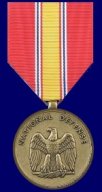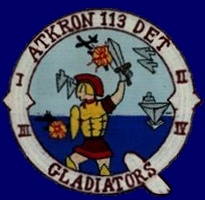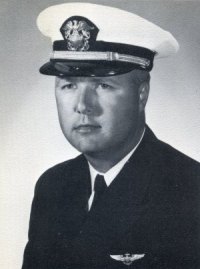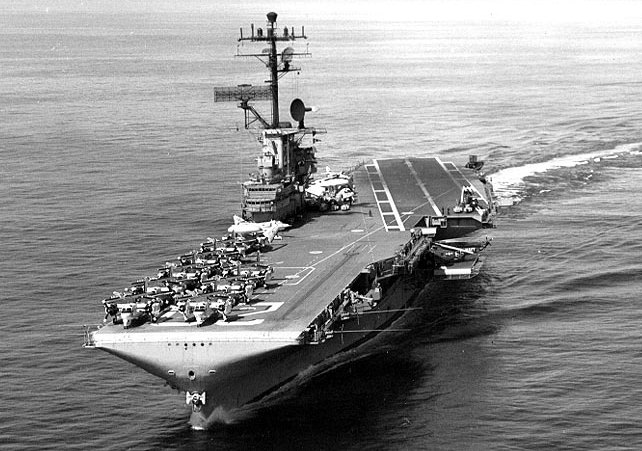|
USS
Bennington (CVS-20) Newsletter 1 October 1965
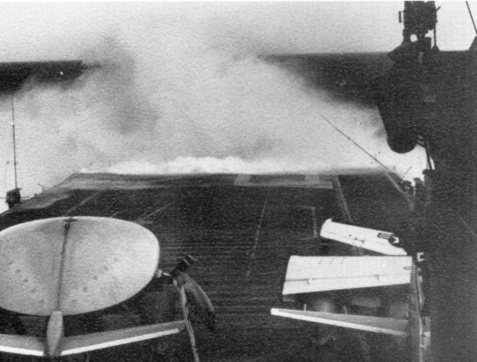
One of the 30 foot waves that Typhoon Trix mustered up
Cascades more that 75 feet over the Benn's bow. |
1 October 1965
En route home!
Dear Families and Friends of Bennington;
Today, everyone in Bennington
is in a very gay, festive mood. “Channel fever is noticeable in every division--the
reason is self-evident, “Bennington is coming home.” The officers
and men have been away from home almost seven months--with seven of every
ten days spent at sea. However, our long period of separation from our
loved ones is eased by the thoughts of a happy and joyous homecoming October
7.
Throughout Bennington, gifts
for our loved ones are stowed in every compartment. And to many, this homecoming
reunion will be another Christmas; and fittingly so, since last Christmas
was spent away from home.
In past letters, I have written
primarily of the fascinating and intriguing sights that the officers and
men of the Bennington have seen traveling throughout the Far East on this
year's cruise. However, since your loved ones will soon be home to tell
you of all their rich experiences, I feel it more significant to give you
a brief operational “recap. “ I hope it will present some ideas of
the teamwork and skill which has enabled the Bennington to fulfill its
seven-month deployment successfully.
The Bennington has covered enough
miles during the last six months to complete two circuits of the world.
To cover these 50,000 odd miles, the ship required approximately 7,500,000
gallons of black oil alone for use in propelling the ship. If
I were to include the number of gallons of aviation gasoline and jet fuel
also consumed during this period, the figure would be increased considerably.
Excessive heat and humidity were
constant factors this summer and our water requirements were unusually
high; particularly when duty commitments kept us in the South China Sea
for nearly sixty days broken only by one short port call in Subic Bay,
Philippines. While in the South China Sea, we used an average of 24 gallons
of water for each man per day. Having four of our eight boilers going around
the clock for such extended periods of time boosted our water requirements
well beyond what is normally consumed on a Westpac cruise. All hands cooperated
in the need to conserve water as much as possible and thus we were not
forced to resort to "water hours" where shower and cleaning water is turned
on at designated hours during the day. The overall figures show that the
Bennington used nearly 15,000,000 gallons of water; 10,000,000 for potable
use and the remainder supplied steam in the ship's propulsion plants. Bennington
produces approximately 100,000 gallons of fresh water daily.
Just as statistics from the
Engineering Department are quite staggering to one's imagination, so are
the figures from our Air Department. Since leaving Long Beach last March,
4,062 arrested landings of fixed-wing aircraft were completed as well as
over 3,000 helicopter landings. With around the clock flight operations
during our surveillance duty in the South China Sea, our fixed wing aircraft
from embarked squadrons: VS-33, VS-38, VAW-11 and VA-113 boosted their
flying hour totals to 10,814, while our helicopter squadron HS-8 totaled
5,210 hours. I am most thankful that during the entire cruise, there
were no casualties or major injuries.
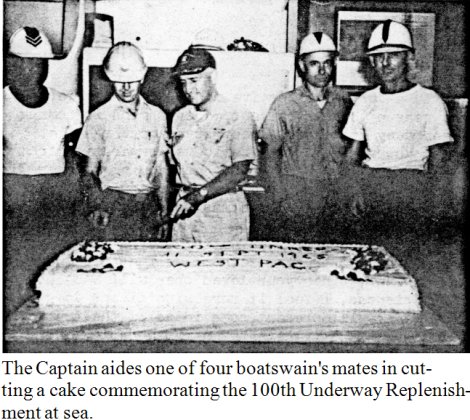 It
is a well-known axiom that "a ship is only as good as its crew." The magnificent
accomplishments of the Bennington's Air Group 59 team during these past
long months on station in the Western Pacific's South China Sea area, have
been a source of continual amazement and utmost pride for me as I have
watched them go about their duties like true professionals and dedicated
Navy men. As in the past, Bennington's men continuously displayed excellent
teamwork and each unit, regardless of its size, played the vital role of
keeping the ship and air group functions running smoothly and effectively. It
is a well-known axiom that "a ship is only as good as its crew." The magnificent
accomplishments of the Bennington's Air Group 59 team during these past
long months on station in the Western Pacific's South China Sea area, have
been a source of continual amazement and utmost pride for me as I have
watched them go about their duties like true professionals and dedicated
Navy men. As in the past, Bennington's men continuously displayed excellent
teamwork and each unit, regardless of its size, played the vital role of
keeping the ship and air group functions running smoothly and effectively.
Because of Bennington's tremendous
size, almost three football fields long, it is impossible to go into much
detail regarding each division aboard, but I will try to give you an overall
look into each department.
The Air Department, the second
largest on board, is composed of five divisions-whose members are recognized
by brightly colored long sleeved jerseys.
On the flight deck, the V-1
division handles all aircraft when on they come from the hangar bay.
The "yellow shirts" are traffic directors, the "blue shirts" are plane
handlers and the "red shirts" are damage repairmen. This colorful team's
duties are
exacting and require a thorough knowledge of the aircraft.
Once a plane has landed, it must be quickly moved forward to allow for
the next plane. Throughout the cruise continuous 24-hour flight operations
were the order of the day. At night as you may well imagine, aircraft movement
on the flight deck requires exceptional individual alertness.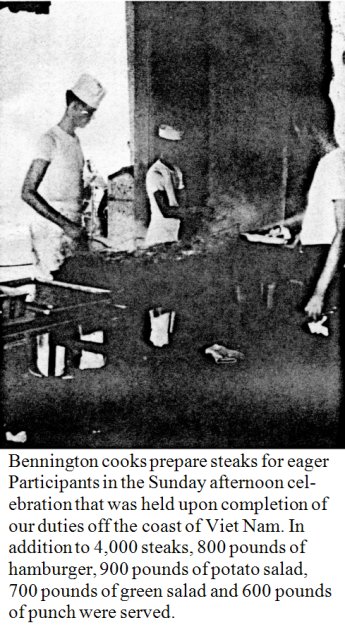
The other flight deck division,
V-2 or "catapult and arresting gears," personnel in green jerseys assume
the responsible task of locking aircraft into position for catapult launchings
and maintain the four steel recovery cables at the landing end of the Bennington's
angled flight deck. Skill and know-how play an important part in this division,
as the slightest failure in any one phase of launching and recovery operations
could result in serious consequences. Though the word “safety" is a key
word in any job aboard the ship, it is imperative that this group be particularly
careful because take-offs and landings are two of a carrier's most critical
operational moments.
Once aboard the ship safely and placed
in their flight deck parking area, the 47 aircraft are maneuvered into
position to be transferred below to the hangar bay by the blue and yellow
shirt of the V-3 division. Once below, air group crews go to work cleaning
their aircraft and thoroughly inspecting the planes for any possible flaws
that may have developed during flight.
The purple shirted personnel
of the v-4 division or "gas kings" assume the important task of stowing,
distributing and use of all aviation fuels on board. The importance of
their task is highlighted by the fact that they care for approximately
one-half million gallons of fuel.
Meanwhile, the V -6 green shirted
start crew members take charge of the maintenance of ground support gear,
tractors, trucks, cars, crash equipment and maintenance shops used by the
air group. These skilled men are also charged with the upkeep and operation
of all vehicles which are used in the loading and offloading of materials
on board the ship. The "brown shirts" man and maintain the invaluable and
trusty C-1A, Benn's mail plane.
I've often though t as I observed
the multi-colored team members during launching and recovery that their
smooth and rhythmic precision strongly resembled a ballet.
Assisting and supporting the
air group is the primary mission of each of the departments aboard. Operations
is one department which works quite closely with air and the squadrons
in planning, coordinating and scheduling both ship's movements as well
as
flight operations. The department also disseminates information from Combat
Information Center, Antisubmarine Classification and Analysis Center (ASCAC)
and the Carrier Air Traffic Control Center (CATCC) and the weather office.
Operations has
air group personnel. In an average month approximately
1,200 patients were treated and 4,000 separate dental procedures accomplished.
Safe passage through the troubled
waters in our 1965 cruise was attributed to the precise information provided
by the Navigation Department. The Navigator and the quartermasters of "N"
division kept me informed of up-to-the-minute ship's position and minute
changes in the tides and wind and weather which aided "Big Benn" in avoiding
all navigational hazards. In addition to the major task of navigating the
ship, the Navigator carried out individual training for all bridge watchstanders
with a resulting increase in rates for quartermasters and qualifications
of many air group officers as "Officer of the Deck Underway."
Our operation would be completely
crippled without the vital role played by the Supply Department which provides
the ship with nuts and bolts, rags and swabs, resistors, pens and paper.
All those items required to keep the ship "shipshape" are stored and distributed
by the S-1 division in 34 storerooms. S-2 division feeds the crew for some
13 hours a day; 3 meals and midnight rations. Trying to perform the duties
normally carried on by some 2,500 wives and mothers is quite an undertaking.
The important task of cleaning up is handled by the S-2L division, the
division that most "boots" or new men are assigned to when they first report
aboard. Sales and service is taken care of by the men of S-3. They provide
the crew with clothing, laundry service, tailoring, shoe repairs, haircuts
and dispense candy, ice cream, tobacco and necessity items in the ship's
stores, soda fountain and vending machines. Every other Thursday the disbursing
clerks in S-4 division pay the crew its hard earned wages. Serving the
ship's officers is entrusted to the stewards of S-5 division. And lastly,
the S-6 personnel stock an inventory of some 5,000 different items valued
at over 7 million dollars in aviation stores.
The outstanding Bennington Weapons
Department, officially the best in the Pacific Fleet, is divided into four
basic groups under the Weapons Officer; the Ordnance Group, the Deck Group,
Special Weapons and the Marine Detachment. The department's 300 men under
19 officers accomplish the mission of ship's defense and deck seamanship
operations in a most expert manner. Their excellence is attested to by
the fact that this is the second consecutive' year that the department
has been awarded the Navy's Battle Efficiency Award for the Pacific Fleet
CVS Weapons Departments.
The primary mission of the Communications
Department is to provide and maintain reliable, secure and rapid communications
as well as to handle the voluminous routine message traffic. It is not
uncommon for the department to handle a thousand messages a day which includes
those of happiness and sorrow from home. The general mission breaks down
into two jobs that are routine to communications personnel; the radioman
has the task of' maintaining numerous voice circuits for tactical maneuvers
to insure coordination between units in company while the signalman must
be constantly alert for visual contacts and tactical signals displayed
by other units in the area.
Bennington is the flagship of
Commander Antisubmarine Warfare Group Five and
his staff who are responsible for the planning and coordination
of ASW training exercises as well as combined operations with allied forces;
development and evaluation of procedures, doctrines and tactics, cold war
operations; attainment and retention of ASW readiness and other associated
missions in this field. During the WestPac deployment our ASW task group
operating under the control of COMASWGRUFIVE was composed of the Bennington
with her embarked Air Group, CVSG-59, consisting of three aircraft squadrons
and two aircraft detachments assigned, plus eight destroyers.
The cooperation and teamwork
that existed throughout the cruise has been most satisfying. You should
feel proud of the services that your sons, husbands and friends have provided
their country in carrying out Bennington's important task of proving her
capability of fulfilling any assignment given her officers and men.
At this time I must say goodbye
to each of you as within a short time I will be re-assigned to anew, and
I hope as rewarding, command as Bennington. May peace and joy be with you
and your loved ones always.
Very sincerely,

MARVIN E. BARNETT
Captain, U.S. Navy
Commanding Officer
|
